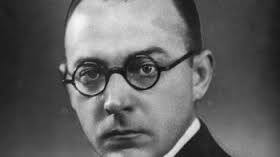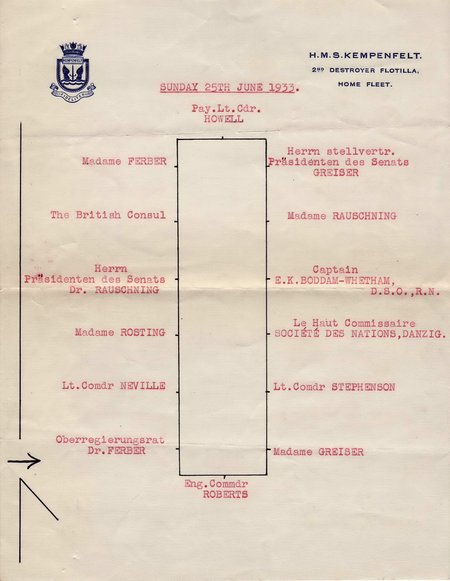Between Internationalism and National Socialism - Helmer Rosting in the League of Nations Secretariat
Blog entry by Karen Gram-Skjoldager (Associate Professor - Aarhus University)
Sometimes people ask where the idea for The Invention of International Bureaucracy-project came from. Apparently, it isn’t self-evident why we would want to spend years studying deceased civil servants in a defunct international organization like the League of Nations.
The question is not easy to answer; the project has grown out of a tangle of different ideas and inspirations. Some of these come from the rich historiography on the League of Nations that has emerged over the last decade. Others are rooted in present political debates where the lack of efficiency and political legitimacy among bureaucrats and technocrats of the European Union is a recurring theme. Others again are mental luggage that has travelled with me from work I have done before on other micro managers of international politics such as diplomats and international lawyers.
However, it was one particular person who came to be the catalyst for the project: Helmer Rosting. Rosting was born in 1893 in the small Danish town of Thisted, a trained theologian and the first Dane to work in the League of Nations Secretariat. I came across Rosting while teaching a methods course in international and global history some years ago. The class was to discuss transnational biographies and as part of my preparation I searched for a Danish member of the League Secretariat who might serve as an example.

(Helmer Rosting - photographer unknown)
I immediately became fascinated by Rosting’s strange and unusual life story. At first glance he seems a familiar and predictable historical figure who fits in nicely with other Scandinavian internationalists such as Fridtjof Nansen, Hjalmar Branting and Christian Lange who worked to promote humanitarianism and international cooperation in inter-war Europe. Rosting’s first job was as a humanitarian activist during the First World War, where he worked for YMCA’s War Prisoners Aid program in France. He went on to work for the International Red Cross after the ceasefire in 1918, before taking up work with the League Secretariat. Starting in the section which oversaw the protection of national minorities in the newly formed Central and Eastern European States, he worked his way to the top of the Secretariat. In 1930 he became head of the office that dealt with the international administration of the Saar and Danzig (Gdansk) areas and in 1932 he was appointed to the prestigious position of High Commissioner of Danzig, a semi-autonomous, German city state, situated on Polish territory, under League protection. Rosting’s work both in the minority section and in Danzig was highly acclaimed and in 1934 he was promoted to head of the minority section, making him the highest ranking Danish member of the League of Nations Secretariat.

(HMS Kempenfelt Seating Plan 25 June 1933 E - Rosting with wife dining together with Hermann Rausching)
However, in 1933, while High Commissioner of Danzig, Rosting’s life took an unexpected and troubling turn. At that time, Hitler came to power in Germany and the local Nazi party under the leadership of German conservative revolutionary, Hermann Rauschning, came to power in Danzig. Rosting befriended Rauschning and was soon well acquainted with leading Nazi civil servants in Berlin and the top brass of the Nazified German Red Cross. This became the start of an ideological slide to the right. When he returned from Danzig to take up the position as head of the League’s minority section in 1934, he had essentially lost faith in the system he was directing. Rosting criticized the League’s overly bureaucratic administration of Danzig and recommended its termination. Indeed, by now he questioned the entire minority protection regime.
In 1936 he left the League and returned to Denmark, where he became involved with The National League, one of many small, radical right-wing parties and organizations operating on the fringes of Danish politics in the inter-war years, whose aim was to replace the feeble representative democracy with an elite-led polity under the leadership of the Danish king. Rosting now publicly criticized the League of Nations, which he claimed had become an empty, paralyzed debating club infiltrated by Jews and free masons using the organization to launch unwarranted attacks against fascist regimes.
When Denmark was occupied by Germany on 9 April 1940, Rosting had taken up work with the Red Cross again, this time as head of international affairs for Danish Red Cross. In September 1940 he openly declared his support for the National Socialist regime and was in fact considered a potential Foreign Minister, should the democratically elected Danish government, still in office after the German occupation, be substituted for a National Socialist government under German control.
The combination of a prominent position in the Red Cross and Nazi sympathies was obviously problematic. Nonetheless, Rosting kept his job; having a leading figure with friendly relations to the German authorities was a valuable asset to the Red Cross that could help prevent a more far-reaching Nazification like the one Norwegian Red Cross underwent.
However, having a National Socialist in a humanitarian key position proved to have consequences. In 1943 Rosting used his position with the Red Cross to float a plan with the Germen political representative in Denmark, Dr. Werner Best, to incarcerate the Danish Jews. The background for the suggestion was the political unrest that had spread during the summer of 1943, which led to the Danish government stepping down and German interment of the Danish military. In this situation Rosting suggested that Danish military personnel be released and replaced by Danish Jews, who could serve as hostages to curb resistance: for every new act of sabotage, Rosting suggested, 50 or 100 Jews should be deported to German concentration camps.
The proposal was not accepted and instead a direct German campaign against the Danish Jews was launched which led to around 500 Jews being deported to the Theresienstadt concentration camp. In this situation Rosting refused to answer a call from the Danish Ministry of Social Affairs to let the Red Cross deliver food and medicine funded by the Ministry to the deported Jews, arguing that they were not prisoners of war.
At the end of the war, Rosting was arrested by the Danish resistance movement. Though quickly released, the arrest caused him to have a nervous breakdown and he took his own life on 28 June 1945.
Rosting’s life story and the way it connects ideological strands which are usually perceived as fundamental opposites is in itself fascinating. However, it also highlights how and why we should study the League of Nations Secretariat. For one it shows us that the League’s Secretariat was not a closed entity but a structure that was, by way of its employees, deeply embedded in transnational and national structures and contexts; Rosting, like many other members of the Secretariat moved between transnational NGO’s, different posts in the League and government employment. The League Secretariat, therefore, serves as a prism through which we can grasp the broader ecosystem of social and political systems of the time. To return to Rosting’s example: Without knowledge of his work for the Red Cross and his work for the League in Danzig it becomes difficult to make sense of his seemingly contradictory ideological stance in Denmark during the Second World War.
Rosting’s example also shows us that if we want to understand the nature and importance of the League Secretariat, we should not only focus on its formal setup or portray its leading figures and prominent public representatives, but also include the many lesser-known men and women who at various times walked the halls of the Palais des Nations. Studying international organizations is essentially about studying human beings: it is telling of any organization what kind of people they attract, what kinds of careers they allow for, and which forms of political and cultural capital their employees can accumulate and how that capital facilitates subsequent careers in other organizational settings. We have a good idea about how these things played out for Helmer Rosting, but for the many hundreds of other people who worked for the League of Nations we have only just started scratching the surface.
The description of Hjalmar Rosting in this blog post is based on:
Christoph Güterman: Das Minderheitenschutzverfahren des Völkerbundes, Duncker & Humblot Berlin 1979
Hans Sode-Madsen: ””Åndeligt værnemageri”? Helmer Rosting og Dansk Røde Kors 1943-45”, in: John T. Lauridsen (ed.): Over stregen – under besættelsen, Gyldendal, Copenhagen, 2007, pp.730-751
http://denstoredanske.dk/Dansk_Biografisk_Leksikon/Samfund,_jura_og_politik/Myndigheder_og_politisk_styre/Embedsmand/Helmer_Rosting (accessed 28 October 2016)
The seating plan (HMS Kempenfelt Seating Plan 25 June 1933 E) was found at:
http://frankstaylorfamilyandroyalnavyhistory.net/HMSKempenfelt/HMSKempenfeltTheCaptain'sTable.html (last visited 03.11.2016)
If you feel that one or both of the pictures are incorrectly acknowledged, please do contact us at: haakon.ikonomou@cas.au.dk
